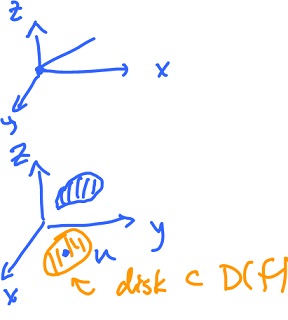This site is being phased out.
Limit of function
We concentrate on limits of functions at the limit points of their domains.
Example. Consider
f(x) = x for x ≠ 1.
with
D(f) = ( -∞, 1 ) ∪ ( 1, ∞ ).
Even though the function is undefined at 1, the limit
limx→1 f(x)
makes sense, because 1 is a limit point of D(f).
Example. Let
f(x) = 1,
D(f) = { 0 } ∪ [ 0, 2 ).
Here the limit
limx→0 f(x)
does not make sense.
Example. Also, if
D(f) = ( 1, ∞ ),
then the limit
limx→∞ f(x)
does make sense.
Definition. Suppose
f: ℝn → ℝ
and a a limit point of D(f). Then L ∈ ℝ is the limit of f as x → a if
for any ε > 0 there is a δ > 0 such that ‖ x - a ‖ < δ with x ∈ D(f) => | f(x) - L | < ε.
Note 1: there is always such an x - on the right - for any δ > 0.)
Note 2: if f: ℝn → ℝm, then L ∈ ℝm and we replace in the definition the absolute value |.| with the norm ‖.‖ , as before:
‖ x - a ‖ < δ with x ∈ D(f) => | f(x) - L | < ε.
Note 3: Is the limit well-defined?
Theorem (Uniqueness of Limit). If L and M satisfy the definition, then L = M.
Proof'.' Let L ≠ M, L, M ∈ ℝ. Say
L > M,
then let
ε = ( L - M ) / 2.
Apply the definition with this ε. Then there is a δ satisfying the condition. Now choose x ∈ D(f) with
‖ x - a ‖ < δ.
Then it follows that
| f(x) - L | < ε, | f(x) - M | < ε.
(Provide the details here!) Then
| f(x) - L | + | f(x) - M | < 2ε = L - M.
Finish the proof. QED
Theorem. Let
limx→a f(x) = L, limx→a g(x) = M.
Then
(1) limx→a ( f(x) + g(x) ) = L + M, (2) limx→a ( f(x) ⋅ g(x) ) = L ⋅ M, (3) limx→a ( f(x) / g(x) ) = L / M, provided M ≠ 0.
Theorem (Limits Under Composition). For the two cases
(1) f: ℝ → ℝn, g: ℝn → ℝ, (2) f: ℝn → ℝ, g: ℝ → ℝn
let
limx→a f(x) = L, limt→L g(t) = M.
Then
limx→a ( g ∘f )(x) = M.
Theorem. The function f is continuous at x = a iff
limx→a f(x) = f(a).
The point a is a limit point of D(f).
Example. Let
f( x, y ) = x + y continuous on D(f),
D(f) = { ( x, 0 ): x ∈ ℝ } ⊂ ℝ2.
Consider points in D(f) that have a ball around them that lies entirely in D(f), interior point D(f). (This is unlike the first example.)
Definition. Given A ⊂ ℝn, the point a ∈ A is called an interior point of A if there is an ε > 0 such that
B( a, ε ) ⊂ A.
Let n = 1. Is a an interior point of A = { a }? No.
A = [ 0, 1 ]. What are the interior points? All but 0 and 1.
The set of all interior points of A is called the interior of A, and we write int A.
The interior
int [ 0, 1 ] = ( 0, 1 ),
as the limit points of [ 0, 1 ] are [ 0, 1 ], so 0 and 1 are limit points but not interior points.
Is vice versa possible? No. Every interior point is a limit point (see Theorem).
Consider
B( a, r ) = { x ∈ ℝn: | x - a | ≤ r }, a closed ball,
then
int B( a, r ) = { x ∈ ℝn: | x - a | < r },
i.e. an open ball.

